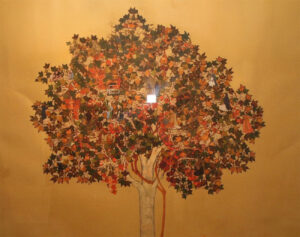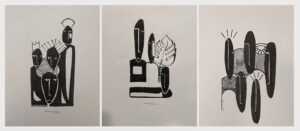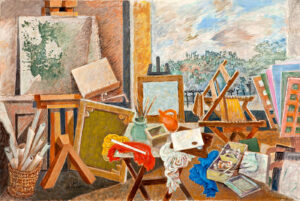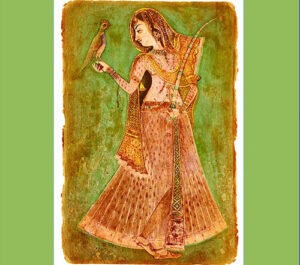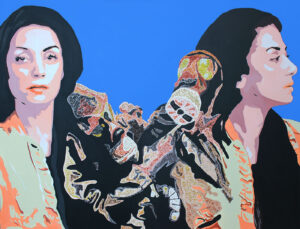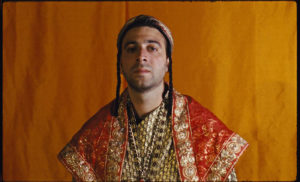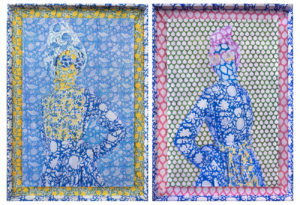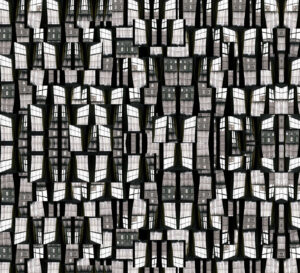Science fiction and dystopias figure prominently in Arab literature going back more than 100 years.
With the advent of modern art movements in the Islamic world, artists began to freely experiment with the signs, symbols, and materials of Islamic heritage in modern artworks. Foremost among these is the crescent moon, which became an adaptable modernist shape in the paintings of Sudanese artist Ibrahim El-Salahi (b. 1930) and Iraqi artist Jawad Selim (1921-1961). As a readily recognizable symbol in Islamic architectural and religious practices, the crescent arch offered mid-twentieth-century artists the opportunity to create artworks with specifically Islamic cultural resonances within a larger, global modern landscape. Together, El-Salahi, Selim, and other artists use the crescent to instill celestial symbolism into modernist abstract forms in order to generate evocative images of the cycles of life.
A key example is Ibrahim El-Salahi’s painting “The Last Sound” (1964), which inserts the lunar crescent among other cosmic bodies and calligraphic signs as a way of depicting African Muslim mourning rites, as well as to suggest a dying person’s passage from the worldly to the celestial realm. Born to a Muslim cleric, El-Salahi grew up exposed to Qur’anic calligraphic scripts and he maintained an artistic interest in popular Islamic motifs like the crescent and arabesque (see Salah Hassan on “Ibrahim El Salahi” in Nka, Fall/Winter 1998, 28-33). In “The Last Sound,” El-Salahi harnesses multiple emblematic traditions of the crescent image, in particular Islamic poetic and calligraphic traditions comparing the Arabic nun, or canoe-shaped “n” letter, to the crescent moon. His composition shows the point-filled, arching nun shapes comingling with astronomic spheres and vaulting archways. As a celestial nun, the moon in his “The Last Sound” thus serves as a visual and vocal vehicle to transport viewers on an allegorical journey into a larger symbolic cosmos.

Jawad Selim also used the crescent motif in his painted canvases and three-dimensional works, in which the crescent functioned as the primary graphic element for the crafting of similarly curved images such as palm trees, watermelon slices, and human faces (for discussion of these hilaliyat or crescent forms in Jawad Salim’s oeuvre, see Salim, Iraqi Contemporary Art, 105-110, and Shabout, “On Abstraction and Symbolism: Jewad Selim,” 71-74). Among others, Selim’s 1954 sculptural work “Motherhood” uses the crescent arc as a symbolic three-dimensional vessel for the conception and gestation of life. A black-and-white photographic reproduction of “Motherhood” from a 1968 retrospective exhibition catalog presents the sculpture as though it simultaneously rests on and constitutes the surface of the moon, while enveloping the hanging spherical seed within its inner arc. The artwork’s shadowy and cratered surface as well as its small dangling orb echo the world’s first photograph of earth taken from the vicinity of the moon by the 1966 NASA Lunar Orbiter 1 spacecraft. Its perspective also anticipates the “Earthrise” photograph taken by Apollo 8 astronaut Bill Anders at the end of 1968.[1]
For “Motherhood,” Selim linked human creation to the lunar form. He also turned to Iraqi cultural histories of the Fertile Crescent to suggest propagation and growth. With the 1954 sculpture, wide-ranging allusions from ancient Mesopotamian fertility goddess sculptures to modernist ideologies of the “motherland” in nation-state building show that the “symbolism embodied in motherhood creates a link between the past, present, and future” for Iraq, as Nada Shabout has noted. The artist’s maternal crescent and embryonic star thus traverse time and space, underpinned by various cultural and political meanings.
Additionally, the sphere or star floating from the arc’s tip into the curved sculptural interior likewise carries the Arabic letter nun to another symbolic level. Here, the nun pays tribute to Islamic lettrist thought, which posits that all letters of the Arabic alphabet include mystical dimensions (see Annemarie Schimmel, “Calligraphy and Mysticism”). In chapter 68 of the Qur’an, i.e., Surat al-Qalam (also known as Surat al-Nun), the holy text praises the letter nun at the same time as it invokes the generative pen of God. Over the centuries, the nun was thought to bear affinities with the primordial inkwell and progenitor point (nuqta) from God’s cosmological pen, which created the entire universe and mankind. Selim’s “Motherhood” hence can be understood as the process of creation encapsulated as a cosmic, realized nun.
In both of these examples, we can see how modern and contemporary artists based in the Middle East have experimented with the moon to contend with and transform Islamic visual heritage through their own artmaking practices. Other trajectories for dynamic relationships between modern art and artistic traditions in Islamic history include premodern book arts, architectural structures, popular folk arts, traditional crafts, and religious votive materials.[2] Such artistic engagements with historical forms and motifs to create futuristic imaginings via scientific and technological innovation provide another staging ground for the creative mediation of Islamic heritage.
Speculative narratives, otherwise known as science fiction or the “literature of ideas,” offer projected re-imaginings of human experience by depicting new or imaginary technologies, time and space travel, alien beings, and utopian or dystopian worlds. Besides literary works, science fiction offers artists visual tools to imagine — or reimagine — the world as it was, is, or will be. Within the literary history of science fiction, the moon plays a formative role leading up to and during the international space race to the moon. Writers and artists active in the Islamic world were no exception to the rule. They, too, pivoted between historic engagements with lunar imagery and ventures in futuristic imagery. These creative entrepreneurs experimented with science fiction as a way to reflect upon themselves and their position in the world and greater cosmos.[3]
Known in Arabic as al-khayal al-‘ilmi or “scientific imagination,” science fiction has deep roots in Islamic cultures. In premodern Islamic literary traditions, speculative imagination encompasses a wide range of fantasy tales and mythic narratives. Among them can be counted the stories in One Thousand and One Nights and works falling in the ‘aja’ib (“marvels”) genre, which continued to reverberate in modern science fiction. The thirteenth-century writer, astronomer, and physician Zakariya al-Qazwini penned his famous cosmography ‘Aja’ib al-makhluqat wa-ghara’ib al-mawjudat (“Wonders of Creation and Marvels of Creatures”) and he also wrote the proto-science-fiction tale Awaj bin Anfaq, about a man who journeys to earth from a faraway planet. Some of these premodern tales make a reappearance in modernist writings during the late nineteenth and early twentieth century, especially in Egyptian radio broadcasts, theater, print publications, and cultural arts magazines. For example, Egyptian writer Yusuf ‘Izaddin ‘Isa (1914-1999) popularized science fiction radio broadcasts in the 1940s, and is considered a pioneering voice in modern Arabic science fiction. Another prominent Egyptian science fiction writer, Mustafa Mahmud (1921-2009), produced several landmark novels, including the 1965 novella Al-‘Anqabut (“The Spider”). These and other works inspired a new generation of science fiction writers in the Middle East.

The preeminent figure in modern Arabic science fiction is Egyptian playwright and writer Tawfiq al-Hakim (1898-1987). While his most famous publication is the 1957 play Voyage to Tomorrow featuring interstellar time travel into a dystopian future, several of his other works center on the moon. Following the 1969 NASA Apollo 11 landing, and five subsequent U.S. manned-missions to the lunar surface between 1969 and 1972, al-Hakim published several works dealing with the moon as an inhabited world. For instance, his short story “Taqrir Qamari” (“Moon Account”) describes aliens on the moon observing humans on earth, while his play Sha‘ir ‘ala al-Qamar (“Poet on the Moon”), written in 1972, uses the lunar landscape as a metaphoric stage for critically assessing the role of art in society. Through such sci-fi narratives, Tawfiq al-Hakim and other writers conjured stories on the moon while critiquing a number of pressing issues, including religion, philosophy, authoritarianism, warfare, humanity’s relationship to nature, and the potential negative effects of scientific advancement on the world’s environment.

As speculative authors aimed to reach new heights, literary print publications commemorated their voyages across the cultural imaginary with out-of-this-world graphic designs typical of sci-fi pulp cover arts.[4] One example can be found in Syrian science fiction writer Talib ‘Umran’s (b. 1948) 1985 novel Khalfa Hajiz al-Zaman (“Behind the Veil of Time”). The sci-fi book cover depicts a futuristic silver spaceship with spindly, bent legs hovering in front of a sunset horizon. Designed by Syrian artist Anwar al-Rahbi (b. 1957), the cover illustration contrasts the romantic realism of a pastoral landscape with the otherworldliness of the two main characters’ spacecraft bound for the planet “Love Moon.”[5] Moreover, for ‘Umran’s 1983 publication Laysa fi al-Qamar Fuqara’ (“The Moon is Not Poor”), the famous Syrian graphic designer Abdul-Qadir Arna’ut (1936-1992) created an understated cover with the moon as a flat white circle in a blue color field dotted with five-point stars (Figure 5). Both books use the moon as a setting for futuristic tales and offer two cover art possibilities for the otherwise uncharted history of Middle Eastern science fiction illustrations.

Beyond the literary arts, the exploratory nature of science fiction also filtered into modern political projects. After coming to power in 1956, Egyptian President Gamal Abdel Nasser’s (1918-1970) state-sponsored propaganda stipulated that Pan-Arabism and socialist politics would enable Middle Eastern nations to participate in the international space race and journey to the moon. In January 1958, for instance, the Cairo-based Al-Hilal (The Crescent) cultural magazine produced a special issue on “The Moon Epoch” in Egyptian nationalism.[6] Included in the special lunar-themed publication was an article entitled, “Men of Letters Outdistanced the Scientists to the Planets,” featuring photographic portraits of H.G. Wells and Edmond Rostand as well as fantasy illustrations of moon-bound spacecraft (safina) (Figure 6).[7] Lebanese artist Marwa Arsanios (b. 1978) reproduced the 1958 magazine spread in her 2012 artist book Words as Silence, Language as Rhymes, as part of her ongoing project engaging with Al-Hilal issues. In her archival work, Arsanios traverses multiple temporalities to explore the failed promises of Egypt’s state-sponsored modernist rhetoric of social progress and women’s emancipation via technological advances by scanning, cutting, and reassembling Al-Hilal pages into new narrative arrangements. By re-editing 1950s print media and ascendant Arab nationalist ideologies of space conquest, Arsanios documents one Middle Eastern nation-state’s unfulfilled expansionist dreams to the moon and stars.

Another contemporary art experiment with science and imagination is the multidisciplinary project The Lebanese Rocket Society.[8] Created by Lebanese artists Joana Hadjithomas (b. 1969) and Khalil Joreige (b. 1969), the documentary film and archival investigation examine the research activities of a student group in 1960s Lebanon who produced the first rockets of the Arab world to travel to Low Earth Orbit. Sparked by a 1964 Lebanese postage stamp of one of the Cedar Rockets (Figure 7), the documentary project gestures towards a forgotten past, or what the artists term “the unrealized imaginary” catalyzed by envisioned aspirations versus actual conditions for rocket launches in Lebanon.[9] The Lebanese Rocket Society returns to a time of transnational optimism for the future when anyone could pursue their passion for knowledge to reach for the heavens, before the 1967 Arab-Israeli Six-Day War dramatically shifted the lived and political realities of individuals living in the Middle East.

When NASA’s Apollo 11 mission landed on the moon on June 20, 1969, over five hundred million people around the world watched their televisions broadcast images of a newly expanded universe. Among them was Iranian-American artist Siah Armajani (b. 1938), who soon after unplugged his television, fastened a lock through the electric plug blades, and stenciled onto the General Electric glass screen: “THIS T.V. SET HAS WITNESSED THE APOLLO 11 MISSION” (Fig. 8). In barring his television set from ever turning on again, Armajani turned the device into a readymade time capsule that commemorates the historic Apollo 11 moon landing and its worldwide visual and audio transmissions. At the same time, fastening a lock to the exterior shell of a memorial or sacred site also happens to be a traditional Iranian votive practice. Armajani’s reenactment with his T.V. set underscores the nature of the 1969 moon landing as a communally venerated event. Similarly, per John Noble Wilford, artists worldwide responded to photographs and texts of “MEN WALK ON THE MOON,” words headlining the next day’s special issue of The New York Times. Armajani chose to retrace the printed prose in the newspaper’s broadsheets with ink over and over again in a kinetic act. He did so, propelled by his desire to inscribe his physical presence into the historical record of the world’s new collective imaginary.[10]

Building upon 1960s artists’ explorations of visual archives, rockets, and spacecraft voyages, recent examples of art experiments with the moon and stars as speculative imaginings reveal fantastic otherworldly landscapes. In a stellar visual tribute to Jerusalem Day, or International al-Quds Day, contemporary Syrian artist Ayham Jabr (b. 1988) digitally pasted a historic photograph of the Dome of the Rock against an enormous rocky mountain range jutting up against the edge of Jerusalem’s venerated Noble Sanctuary (al-haram al-sharif) (Fig. 9). Rising above the snow-capped mountain peaks is a vintage scientific illustration of the solar system, with the earth and its orbiting moon stationed in the third ring around the luminous sun. In the digital collage’s lower right foreground appear two people turning towards the sublime horizon, inviting viewers into the interplanetary landscape while suggesting the internal contemplation of a symbolic world beyond the terrestrial horizon.[11] Taken from an old National Geographic travel photograph of pre-1967 Jerusalem, the image captures a mid-twentieth-century Arab man wearing a red-and-white checkered keffiyah (or shemagh) headscarf, and a woman wearing a silk hair cover, as they both look towards the Dome of the Rock and the astronomic projection. The image thus offers viewers an invitation to ponder the cosmic significance of the sacred site.

Ayham Jabr’s “Jerusalem Day” digital collage interweaves three distinct photographic views of transcendent panoramas: an Islamic architectural shrine, a sublime natural topography, and a celestial vault as rendered through modern astronomy’s diagrammatic representations of the solar system. In addition, through his assemblage of sci-fi fantasy books, old travel magazines, and his own documentary photographs of wartime Damascus, Jabr also creates surreal landscapes as a means to, as he said in our interview, “numb myself from all that madness” in present-day Syria. Jabr’s phantasmagoric collage commemorates Jerusalem Day by reverting the contested city back to its pre-1967 Six-Day War status, when peaceful coexistence for Palestinians living in Jerusalem still seemed viable. Hovering on the edge of the cosmos, this retro-futurist assemblage combining vintage photographs of the recent past offers a temporal release from contemporary reality to reimagine the past, present, and even future of Middle Eastern terrains. By depicting a celestial horizon through both scientific and photographic realism, Jabr conjures up a pictorial realm where sublime images of Jerusalem flow freely out of the past and into the future.

Cosmic time travel also serves to illuminate hidden imaginaries in the artistic practice of Iranian-American artist Ala Ebtekar (b. 1978). In his work “Nightfall (After Asimov & Emerson),” pinpricks of white light dot blue-washed prints of the night sky (Fig. 10). Created from natural light of the moon and stars over northern California, these cyanotype prints use a photographic printing process invented in 1842 by English astronomer John Herschel.[12] The photosensitive image process uses two chemicals, ferric ammonium citrate and potassium ferricyanide, which develop when exposed to light into the distinctive dark blue dye (known as “Prussian blue” or Berliner blau) often associated with scientific and technical drawings. Rather than reproduce multiples of a single design, Ebtekar’s monochromatic cyan-blue prints stand as time-lapse documents of visual and physical light in the changing night sky as the moon and stars rotate overhead.
These cyanotype exposures are made with printed pages containing text from science fiction writer Isaac Asimov’s short story “Nightfall.” Written in 1941, the novella begins with a quote by Ralph Waldo Emerson written in Nature (1836): “If the stars should appear one night in a thousand years, how would men believe and adore, and preserve for many generations the remembrance of the city of God?”[13] Asimov developed the idea into a dystopian story about a planet constantly illuminated by six suns that never experiences darkness — other than a lunar eclipse once every 2,000 years. The sudden appearance of hundreds of thousands of stars in the night sky, rather than provoking wonder, drives the planet’s inhabitants and scientists insane as they witness the vastness of the dark universe for the very first time.

Blooming across the novella’s printed prose, Ebtekar’s cyanotype illuminations of stars and moonlight revitalize an antiquated scientific printing process onto the pages of “Nightfall” to capture the visible spectrum of light in the night sky (Fig. 10). These blueprints telescope the infiniteness of space and its celestial bodies directly onto Asimov’s paper pages, echoing the contrast of insignificance in cosmic scale experienced by the novella’s planet population. Adding further levels of meanings to his work, Ebtekar uses the intimacy of reading as a staging ground to depict the inner and outer worlds held within a book’s folios — a symbolic conjunction that he also explores in his “36 Views of the Moon” (2018).
These experiments with science fiction practices, otherworldly imaginings, and the artistic heritage of the Islamic world offer new understandings of the primacy of historic materials in shaping contemporary visual landscapes and future possibilities. While these artworks suggest the tenacity and versatility of Islamic traditions, they also demonstrate how artists navigate scientific advances as these intersect with new cultural and scientific horizons. Indeed, working with the imagistic potentialities of science fiction enables artists to unbind themselves from the art historical burden of situating their work “authentically” within Islamic tradition, and instead to freely craft possible futures through the lens of the here and now. From the international space race and 1969 Apollo 11 moon landing to current hyper-visual developments and technological ambivalences exemplified in “Gulf Futurism” art projects,[14] artists of the Middle East continue to explore new artmaking strategies in a world that is constantly changing and reverberating with symbolic matter from the past.[15] These creative engagements with the moon soar, like vessels through time and space, to engender sublime resonances between a historic Islamic past and a future cosmic imaginary.
* Click here for a pdf that includes more detailed footnotes and a bibliography.
Notes
[1] Otherwise known as “the most influential environment photograph ever taken.” See Lazier, “Earthrise; or, The Globalization of the World Picture.”
[2] For a further discussion of the topic, see in particular Al-Bahloly, “History Regained”; Flood, “Picasso the Muslim”; and Lenssen, “Adham Isma‘il’s Arabesque.”
[3] As futurist and cultural critic Ziauddin Sardar notes, “The problems of contemporary Islamic society – the problems of gender, the problems of authoritarianism – all of these are explored very thoroughly in Arab sci-fi. But most importantly of all, it is Arabs reflecting on themselves.” See Green, “Close Encounters of the Arab Kind”; and Khan, “Arab Science Fiction Shines Light on Current Middle East Themes.”
[4] Besides studies of “Techno-Orientalism” and sci-fi pulp fantasy images of the Middle East for Western audiences, research remains to be conducted on popular science fiction illustrations in Islamic lands. For surveys of American and British sci-fi illustrations, see Sadoul, 2000 A.D.: Illustrations from the Golden Age of Science Fiction Pulp; Frewin, One Hundred Years of Science Fiction Illustrations 1840-1940; and Aldiss, Science Fiction Art.
[5] Ian Campbell discusses ‘Umran’s 1985 novel as one of the earliest instances of Arabic science fiction tropes merging with Sufi literary traditions, where a romantic relationship serves as a metaphor for mystical union with the divine. See Arabic Science Fiction, 253-275.
[6] Founded in 1892, Al-Hilal magazine is considered the oldest continuously produced cultural and literary arts journal in the Arab world. After Nasser’s nationalization of the Egyptian press, it became a state media platform.
[7] For similar examples of science fiction illustrations of spherical spacecraft and weapons, see Eisler, Space Wars.
[8] As Hadijthomas states, “the project was not only Lebanese in spirit. The scientists involved were from Armenia, Iraq, Jordan, Jerusalem, Palestine, Syria… people from all over the region joined in to create a rocket.” Quoted in Pontbriand, “Artists at Work,” 8.
[9] Hadjithomas and Joreige, “On the Lebanese Rocket Society.” Also see Elias’s discussion of The Lebanese Rocket Society as a science fiction mode in his Posthumous Images, 171.
[10] Other artists who creatively responded to the 1969 lunar landing include Andy Warhol (1928-1987), Japanese conceptual artist On Kawara (1932-2014), and Nancy Holt (1938-2014). See Lin, “The 1969 Lunar Landing.”
[11] These figures are known as repoussé (French, “pushed back”) or Rückenfigur (German, “figure from the back”). Examining landscape in the science fiction imaginary, John Timberlake argues that: “By counter-posing the anonymous individualized figure to the visual ‘field’ of the landscape, Rückenfiguren of contemporary science fiction qualitatively differ from those of an earlier age: no longer opening potential new horizons for humanity, but rather delineating the horizon of humanity’s potential just as so-called ‘archaeological horizons’ define the epochal extent of vanished civilizations within the strata”; see his Landscape and the Science Fiction Imaginary, 19.
[12] Meaning “dark blue impression,” cyanotype photographic print processes rely on exposure to ultraviolet radiation, whether from the sun or its reflective light on the moon. See Ware, Cyanotype, 22-29.
[13] Isaac Asimov’s paraphrased quotation, from Ralph Waldo Emerson’s “Chapter I” in Nature, 3.
[14] For a discussion of “Sci-Fi Wahhabi” and other Gulf Futurist projects by artist Sophia Al-Maria, see Taubin, “Openings: Sophia Al-Maria.”
[15] Roger Luckhurst describes technological ambivalence as one of the presiding spirits of science fiction engagement; see his Science Fiction, 5.
























